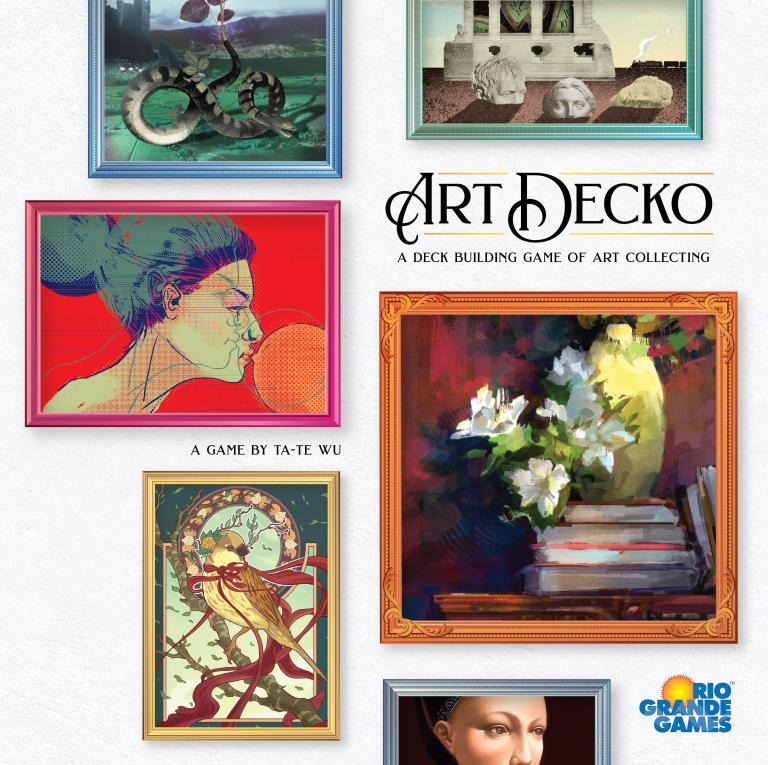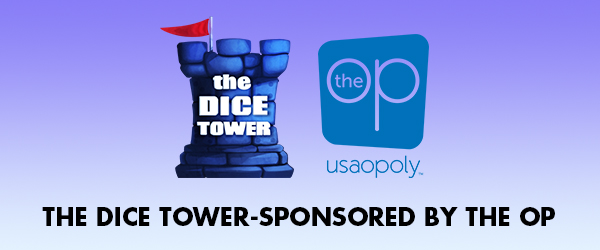Art Decko

Art Decko
Art Decko, first released as Promenade, is a light strategy game for 2 to 4 painting collectors in which you try to create a valuable deck of gold and painting cards over the course of play. These cards — gold and paintings — both count as currencies in the game, and you can use them to purchase more paintings, acquire more gold, and pay for exhibition space in a museum. Your long-term goal is to manipulate the market value of certain styles of artwork, while also earning points by placing paintings in the museum.
The game includes paintings from five styles of art — Art Nouveau, Pop Art, Renaissance, Surrealism, and Impressionism — and you start with five random painting cards in your deck. Each art style starts with a value of 1 gold for a painting. You also have five starting gold cards in your deck, with the cards being worth 1 or 2 gold, with some cards having a special ability on them.
To start the game, shuffle your deck, then take five cards in hand. Fill the four galleries with 2-3 random paintings each, then place two random 3-gold cards (each with a special power) in the bank, along with the deck of 5-gold cards. Paintings in galleries cost 1-8 gold, while gold cards cost 5 or 8 gold. On a turn, take two actions from these three choices, repeating an action, if desired:
• Haggle: Discard a card from your hand to draw two cards from your deck.
• Acquire: Pay the acquisition cost of a painting or gold card by discarding cards from your hand, then place that card in your discard pile. Increase the "market rating" of the painting's art style or gold by the value listed in the gallery/bank. As the market rating of an art style increases, each painting in that style is worth more gold, effectively increasing its buying power; that art style is also worth more points at game's end.
• Exhibit: Pay the exhibition cost for a gallery, then place a painting into that gallery that matches one of that gallery's invitation markers. (A gallery might want, for example, 2 Impressionistic paintings, 1 Renaissance painting, and 1 painting of any type.) Mark that painting with one of your ownership tokens, then place the related invitation marker on the highest available victory point (VP) space, scoring those points for yourself immediately. That painting is now removed from your deck.
If you use the special ability on a gold card instead of its listed numerical value, remove that card from the game.
At the end of your turn, discard any number of cards from your hand, then refill your hand to five cards. If a gallery has no paintings in it, refill all of the galleries with 2-3 paintings, then replace each empty gallery's cost token with the next highest one available. When at least twelve paintings are in the museum, the painting deck is empty, or an art style or gold reaches a market rating of 70, finish the round, then proceed to final scoring.
The value of gold depends on its market rating, with its value ratio ranging from 6:1 to 1:1. Each painting in your deck is worth 1-7 VPs depending on the market rating of its art style. Each exhibition space in the museum also has a random bonus that was revealed at the start of play, and you can earn additional points through these bonuses. In the end, the player with most VPs wins.
The game includes paintings from five styles of art — Art Nouveau, Pop Art, Renaissance, Surrealism, and Impressionism — and you start with five random painting cards in your deck. Each art style starts with a value of 1 gold for a painting. You also have five starting gold cards in your deck, with the cards being worth 1 or 2 gold, with some cards having a special ability on them.
To start the game, shuffle your deck, then take five cards in hand. Fill the four galleries with 2-3 random paintings each, then place two random 3-gold cards (each with a special power) in the bank, along with the deck of 5-gold cards. Paintings in galleries cost 1-8 gold, while gold cards cost 5 or 8 gold. On a turn, take two actions from these three choices, repeating an action, if desired:
• Haggle: Discard a card from your hand to draw two cards from your deck.
• Acquire: Pay the acquisition cost of a painting or gold card by discarding cards from your hand, then place that card in your discard pile. Increase the "market rating" of the painting's art style or gold by the value listed in the gallery/bank. As the market rating of an art style increases, each painting in that style is worth more gold, effectively increasing its buying power; that art style is also worth more points at game's end.
• Exhibit: Pay the exhibition cost for a gallery, then place a painting into that gallery that matches one of that gallery's invitation markers. (A gallery might want, for example, 2 Impressionistic paintings, 1 Renaissance painting, and 1 painting of any type.) Mark that painting with one of your ownership tokens, then place the related invitation marker on the highest available victory point (VP) space, scoring those points for yourself immediately. That painting is now removed from your deck.
If you use the special ability on a gold card instead of its listed numerical value, remove that card from the game.
At the end of your turn, discard any number of cards from your hand, then refill your hand to five cards. If a gallery has no paintings in it, refill all of the galleries with 2-3 paintings, then replace each empty gallery's cost token with the next highest one available. When at least twelve paintings are in the museum, the painting deck is empty, or an art style or gold reaches a market rating of 70, finish the round, then proceed to final scoring.
The value of gold depends on its market rating, with its value ratio ranging from 6:1 to 1:1. Each painting in your deck is worth 1-7 VPs depending on the market rating of its art style. Each exhibition space in the museum also has a random bonus that was revealed at the start of play, and you can earn additional points through these bonuses. In the end, the player with most VPs wins.
Player Count
2
-
4
Playing Time
45
-
60
Age
10
Year Released
2019
Newest Review
Remote video URL

